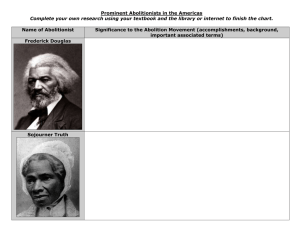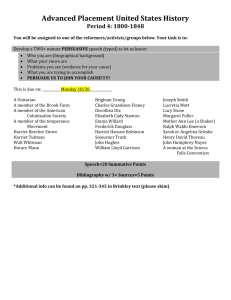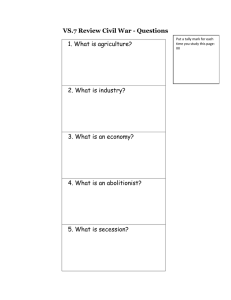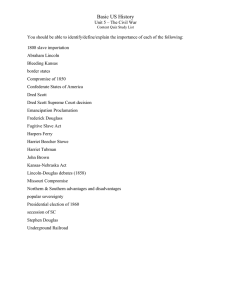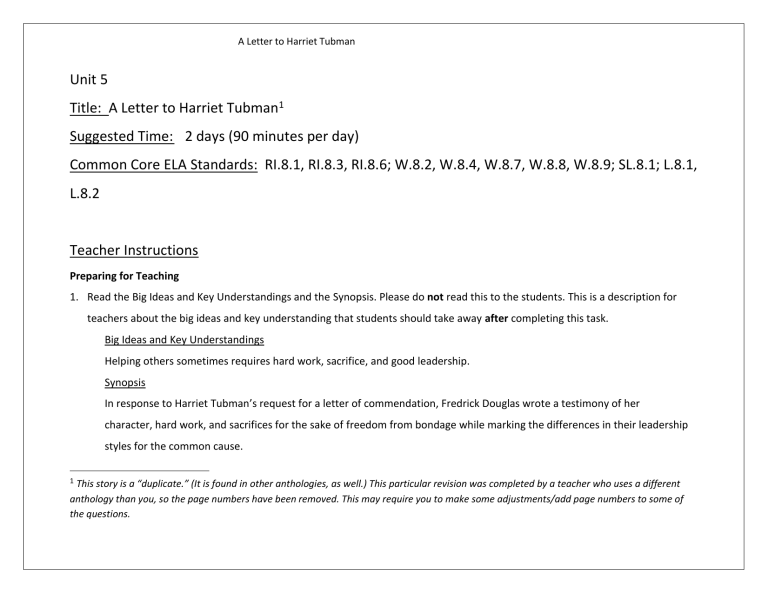
A Letter to Harriet Tubman Unit 5 Title: A Letter to Harriet Tubman1 Suggested Time: 2 days (90 minutes per day) Common Core ELA Standards: RI.8.1, RI.8.3, RI.8.6; W.8.2, W.8.4, W.8.7, W.8.8, W.8.9; SL.8.1; L.8.1, L.8.2 Teacher Instructions Preparing for Teaching 1. Read the Big Ideas and Key Understandings and the Synopsis. Please do not read this to the students. This is a description for teachers about the big ideas and key understanding that students should take away after completing this task. Big Ideas and Key Understandings Helping others sometimes requires hard work, sacrifice, and good leadership. Synopsis In response to Harriet Tubman’s request for a letter of commendation, Fredrick Douglas wrote a testimony of her character, hard work, and sacrifices for the sake of freedom from bondage while marking the differences in their leadership styles for the common cause. 1 This story is a “duplicate.” (It is found in other anthologies, as well.) This particular revision was completed by a teacher who uses a different anthology than you, so the page numbers have been removed. This may require you to make some adjustments/add page numbers to some of the questions. A Letter to Harriet Tubman 2. Read the entire selection, keeping in mind the Big Ideas and Key Understandings. 3. Re-read the text while noting the stopping points for the Text Dependent Questions and teaching Tier II/academic vocabulary. During Teaching 1. Students read the entire selection independently. 2. Teacher reads the text aloud while students follow along or students take turns reading aloud to each other. Depending on the text length and student need, the teacher may choose to read the full text or a passage aloud. For a particularly complex text, the teacher may choose to reverse the order of steps 1 and 2. 3. Students and teacher re-read the text while stopping to respond to and discuss the questions, continually returning to the text. A variety of methods can be used to structure the reading and discussion (i.e., whole class discussion, think-pair-share, independent written response, group work, etc.) Text Dependent Questions Text-dependent Questions Evidence-based Answers Reread the first paragraph. Who wrote this letter, to whom was Frederick Douglas wrote the letter to Harriet in response to her it written, and why was it written? request for a letter of commendation. Douglas writes in his letter “You ask for what you do not need when you call upon me for a word of commendation.” Also, at the end of the letter, he writes, “It is to me a great pleasure and a great testimony to your character and your works…” In the third sentence of the letter, the author states, “I need The writer is saying that he thinks Harriet doesn’t need his such words from you far more than you can need them from words of commendation because her acts speak for me, especially where your superior labors and devotion to the themselves. cause of the lately enslaved of our land are known as I know them.” What is the writer saying in this sentence? A cause is a matter of widespread concern or importance. The cause they both worked for was freedom from slavery. A Letter to Harriet Tubman In the third sentence, what is the cause that the writer is referring to in this sentence? In this same section of the text, Douglas expresses his feelings about Harriet. How does he feel about Harriet? What words lead the reader to feel this way? Douglas uses the words “to the cause of the lately enslaved of our land” when describing Tubman’s hard work and devotion to the cause Douglas feels that Harriet worked much harder for the cause than he did, and he does not feel worthy to even provide a commendation for her superior. He states, “I need such words from you far more than you can need them from me, especially where your superior labors and devotion to the cause of the lately enslaved of our land are known as I know them.” His commendations include: her labors in private, her heroism in facing perils and hardships in leading the slaves out of bondage, and the fact that she had only private rewards. Harriet asks Fredrick Douglas for a commendation, an expression of praise or recommendation, for her biography. In the second paragraph, what does Douglas commend Harriet for? In this paragraph, the writer uses this sentence: “The difference The word marked means noticeable/visible/evident. between us is very marked.” This term means noticeable, Labors Rewards visible, or evident. What does Douglas say are the marked FD Public labors/daytime approved by multitudes of people differences between their labors and their rewards? encouraged every step of the way HT Private labors/night “God bless you” from slaves John Brown was a leader who gave his life for the antislavery Douglas uses the allusion to John Brown to express that John movement. Douglas said of him, “though a white gentleman, Brown gave his life (sacred memory) for the cause of slavery he is in sympathy a black man…” Locate the sentence and that no other person, other than Harriet, has been through “Excepting John Brown—of sacred memory—I know of no one more perils and hardships for the cause. This proves his highest who has willingly encountered more perils and hardships to regard for Harriet. serve our enslaved people than you have.” What is the purpose of the allusion to Brown? A Letter to Harriet Tubman Meaning can be learned from context Tier II/Academic Vocabulary These words require less time to learn These words require more time to learn (They are concrete or describe an object/event/ process/characteristic that is familiar to students) (They are abstract, have multiple meanings, are a part of a word family, or are likely to appear again in future texts) Cause Perils Superior labors Bondage marked Enslaved Meaning needs to be provided A Letter to Harriet Tubman Devotion Wrought Multitude Foot-sore bondmen and women Commendation Bear testimony Improbable Superior Culminating Writing Task Prompt o Frederick Douglas and Harriet Tubman were former slaves who became important leaders in the abolitionist movement. They both made various contributions by working hard and sacrificing their lives for the sake of their cause to free the enslaved people in our country. In an essay, discuss Douglas’ opinion of Harriet Tubman and her efforts and risks as compared to the role he played in the abolitionist movement. Teacher Instructions 1. Students identify their writing task from the prompt provided. 2. Students complete an evidence chart as a pre-writing activity. Teachers should guide students in gathering and using any relevant notes they compiled while reading and answering the text-dependent questions earlier. Some students will need a good deal of help gathering this evidence, especially when this process is new and/or the text is challenging! A Letter to Harriet Tubman Evidence Quote or paraphrase I need such words from you far more than you can need them from me, especially where your superior labors and devotion to the cause of the lately enslaved of our land are known as I know them. Excepting John Brown – of sacred memory – I know of no one who has willingly encountered more perils and hardships to serve our enslaved people than you have Elaboration / explanation of how this evidence supports ideas or argument Douglas feels that Harriet is superior to him because the risks she took for the cause of slavery were far superior than anything that he did. It is to me a great pleasure and a great privilege to bear testimony to your character and your works, and to say to those to whom you may come, that I regard you in every way truthful and trustworthy. Douglas is happy to share Tubman’s dedication, honesty, and hard, dangerous work with anyone. “Most that I have done and suffered in the service of our cause has been in public, and I have received much encouragement at every step of the way.” ”You, on the other hand, have labored in a private way.” “I have wrought in the day—you in the night.” “I have had the applause of the crowd and the satisfaction that comes from being approved by the multitude, while the most that you have done has been witnessed by a few trembling, scarred, and footsore bondmen and women, whom you have led out of the house of bondage and the Douglas worked publicly, by day, with much encouragement while Tubman worked privately, at night, with little encouragement. John Brown gave his life for the abolitionist cause. Douglas feels that other than losing her life, Tubman has worked harder and faced danger more than anyone. A Letter to Harriet Tubman silent stars have been the witnesses of your devotions to freedom and of your heroism.” 3. Once students have completed the evidence chart, they should look back at the writing prompt in order to remind themselves what kind of response they are writing (i.e. expository, analytical, argumentative) and think about the evidence they found. (Depending on the grade level, teachers may want to review students’ evidence charts in some way to ensure accuracy.) From here, students should develop a specific thesis statement. This could be done independently, with a partner, small group, or the entire class. Consider directing students to the following sites to learn more about thesis statements: http://owl.english.purdue.edu/owl/resource/545/01/ OR http://www.indiana.edu/~wts/pamphlets/ thesis_statement.shtml. 4. Students compose a rough draft. With regard to grade level and student ability, teachers should decide how much scaffolding they will provide during this process (i.e. modeling, showing example pieces, sharing work as students go). 5. Students complete final draft. Sample Answer In the “Letter to Harriet Tubman” Frederick Douglas praises Tubman for the devotion and sacrifices that she made for the abolitionist cause. He acknowledges that she was far superior than he in their quest to free the slaves. According to Douglas, though the cause was the same, the difference between their paths was marked. Though both worked hard and were great leaders, Harriet made many more sacrifices to which Douglas felt privileged to bear testimony. Douglas feels that Harriet is superior to him because the labors she took for the cause of slavery were far superior than anything he did. First he includes the fact that she worked privately without the knowledge of the general public by stating, “Most that I have done and suffered in the service of our cause has been in public, and I have received much A Letter to Harriet Tubman encouragement at every step of the way.” “You, on the other hand, have labored in a private way.” He said that the only ones to witness what Harriet did were “a few trembling, scarred and footsore bondsmen and women.” He follows with the statement, “I have had the applause of the crowd and the satisfaction that comes from being approved by the multitude, while the most that you have done has been witnessed by a few trembling, scarred, and footsore bondmen and women, whom you have led out of the house of bondage and the silent stars have been the witnesses of your devotions to freedom and of your heroism.” This indicates that he realizes that those she saved were the only ones that knew the sacrifices she made. He realizes the perils she endured while helping the slaves escape by comparing her to abolitionist John Brown, “Excepting John Brown – of sacred memory – I know of no one who has willingly encountered more perils and hardships to serve our enslaved people than you have.” John Brown was a white abolitionist who was a martyr for the cause of slavery. This allusion is testimony to his regard to her labors for the cause. Though working for the same cause, Douglas is eager to share that Tubman was far superior in her strength, commitment, and bravery than he. In addition, he regarded her as “truthful and trustworthy” in every way. Additional Tasks Harriet Tubman selflessly helped those in need. Think of those in need – the poor, the bullied, the helpless, the victims of crimes and disasters, the abused (including animals) – and the people who come to their rescue. Who are these people? What have they done? Why do they do it? Share your thoughts on a person or a group of people who have helped those in need. Explain the situation and the outcome. Then tell why you think it was/is important. What have you learned from these people. A Letter to Harriet Tubman o Answer: Students should name a specific situation they have encountered either personally, in the news, in a book or magazine. They should then talk about the people who came to the rescue of those in need and why this person/situation affected them. More explanation: Read Ann Petry’s biography - Harriet Tubman: Conductor on the Underground Railroad on pages 260-269 in your textbook. Also skim through the information from the following websites. Then, using information you discover from these sources, write a biological sketch analyzing three attributes Tubman possessed and providing examples of what she did that expressed that attribute. Websites: 1. http://www.pbs.org/wgbh/aia/part4/4p1535.html 2. http://www.biography.com/people/harriet-tubman-9511430?page=3 3. http://www.nyhistory.com/harriettubman/life.htm o Answer: Araminta Harriet Ross was born into slavery in 1819 in Maryland. She later changed her name to Harriet and eventually married John Tubman to become the woman we know as Harriet Tubman. She is one of the greatest American women to ever live. She gained the nicknames “Moses” and “General” for her secretive labors. Because of the woman she was, Harriet Tubman became a significant historical figure. She led hundreds to freedom in the North becoming a leading abolitionist. She is the famous “conductor” on the Underground Railroad (a network to safe houses). Harriet Tubman’s personal background includes several major events in her amazing life. Her biggest obstacle was being born a slave. She lived a life of physical and mental abuse and hardships by enduring numerous beatings and injuries from slave owners. Harriet was able to escape slavery in 1849 and made it her mission to rescue her family and others from a life of slavery. In order for Harriet to accomplish all the things she did, she had to overcome this adversity. A Letter to Harriet Tubman Harriet Tubman had many great attributes including bravery. As a young teen, she was seriously injured to the head by a white overseer for blocking the overseer from reaching a field hand and refusing to help tie up the man who had attempted to escape to freedom. She suffered from narcolepsy the rest of her life. As a young woman she escaped for freedom with her brothers. When they saw their wanted posters, her brothers returned home, but Harriet followed the path to freedom along. Finally, she made 19 trips to slave country, and it is believed that she led 300 slaves to freedom. Not only was she brave, she was also determined. Harriet worked to free all slaves with the fear of being captured not being an option. Tubman showed her determination by continuing in her cause to free slaves even after she was a wanted woman with a $40,000 reward offered for her capture. She made several trips and gained the name “Moses” because of leading her people into freedom. After the slaves were freed, Tubman supported causes such as women’s rights and the care of the aged and indigent She also proved to be smart and clever as she avoided being captured as she worked to free all slaves. She planned each slave escape. She sometimes traveled south to outsmart slave hunters; when slave hunters were close by she often used a drug she used to keep a baby quiet. In addition, her escapes were on Saturday nights because runaway notices couldn’t be released until Mondays. In addition to leading slaves to freedom into Canada, Tubman also served as a spy and scout for the Union during the Civil War. She planned and guided the Combahee River Raid that resulted in the liberation of 700 slaves. . Harriet Tubman once said, “I was the conductor of the Underground Railroad for eight years, and I can say what most conductors can’t say; I never ran my train off the track, and I never lost a passenger.” Harriet Tubman remained true to her causes for freedom, equality, and support for the needy by never letting obstacles get in her way. Evidence Quote or paraphrase “Harriet Tubman devised clever techniques that helped make her “forays” successful…..” Elaboration / explanation of how this evidence supports ideas or argument Tubman was a very clever woman who carefully planned when and how to move the slaves, she used the master’s horse and buggy; left on a A Letter to Harriet Tubman Saturday night for a one-day head start; sometimes headed south to fool those chasing her. Harriet planned a Union expedition that saved 700 slaves. “I was the conductor of the Underground Railroad Tubman showed her determination by continuing in her cause to free slaves even after she was a for eight years, and I can say what most wanted woman with a $40,000 reward offered for conductors can’t say; I never ran my train off the her capture. She made several trips and gained track, and I never lost a passenger.” the name “Moses” because of leading her people into freedom. After the slaves were freed, Tubman supported causes such as women’s rights and the care of the aged and indigent. While still in her early teens, she suffered an Harriet showed bravery whey as a young girl she injury that would follow her for the rest of her life. stood up for what she believed in by defending a Always ready to stand up for someone else, she field had who was being beaten blocked a doorway to protect another slave from Harriet showed bravery when she escaped slavery an angry overseer. The overseer threw a 2-pound as a young woman. She left with her brothers, but weight at the field hand. It missed him and hit they turned back leaving her to travel alone to Tubman on the head. She never fully recovered freedom. and suffered from narcolepsy the rest of her life. Harriet showed bravery by never giving up on the cause for freedom from bondage. Harriet was moving the largest group she ever had This was new to Harriet because she was truly led to freedom - 11 slaves at one time including afraid but kept moving toward Canada because family members and had to take a different route. she wouldn’t let them down. She knew she would be hanged if they were caught but led them to freedom. A Letter to Harriet Tubman Note to Teacher Use several vocabulary strategies that you are comfortable with, but be sure to vary as much as possible. In addition, pictures speak a thousand words and are very effective because students really pay attention to them. Several sentences in this letter are difficult syntactically and students may need scaffolding. A Letter to Harriet Tubman Name _____________________________________________ Date _______________ “A Letter to Harriet Tubman” 1. Reread the first paragraph. Who wrote this letter, to whom was it written, and why was it written? 2. In the third sentence of the letter, the author states, “I need such words from you far more than you can need them from me, especially where your superior labors and devotion to the cause of the lately enslaved of our land are known as I know them.” What is the writer saying in this sentence? 3. A cause is a matter of widespread concern or importance. In the third sentence, what is the cause that the writer is referring to in this sentence? 4. In this same section of the text, Douglas expresses his feelings about Harriet. How does he feel about Harriet? What words lead the reader to feel this way? A Letter to Harriet Tubman 5. Harriet asks Fredrick Douglas for a commendation, an expression of praise or recommendation, for her biography. In the second paragraph, what does Douglas commend Harriet for? 6. In this paragraph, the writer uses this sentence: “The difference between us is very marked.” This term means noticeable, visible, or evident. What does Douglas say are the marked differences between their labors and their rewards? 7. John Brown was a leader who gave his life for the antislavery movement. Douglas said of him, “though a white gentleman, he is in sympathy a black man…” Locate the sentence “Excepting John Brown—of sacred memory—I know of no one who has willingly encountered more perils and hardships to serve our enslaved people than you have.” What is the purpose of the allusion to Brown?
